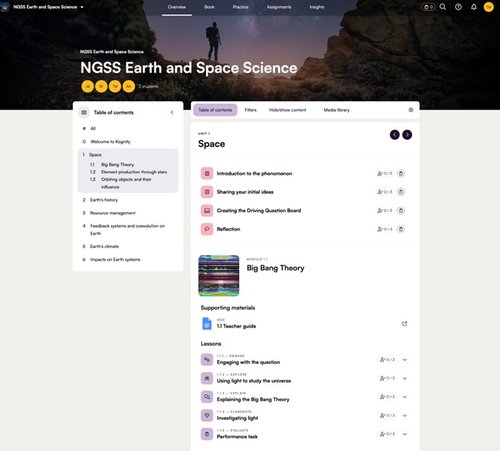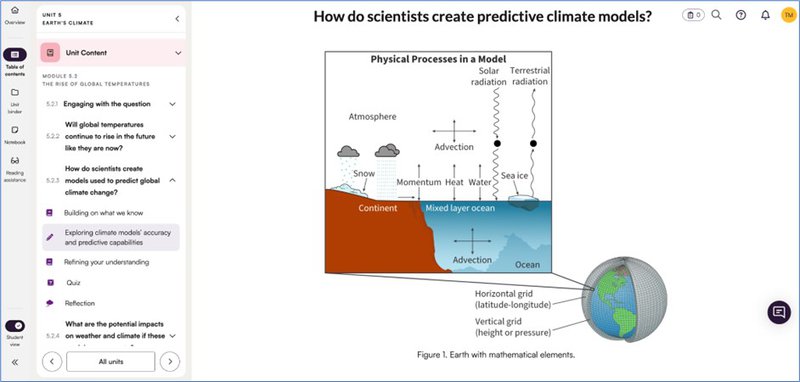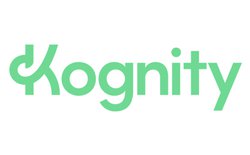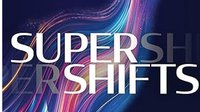Kognity’s new Earth and Space Science course includes six units, each of which begins with an anchoring phenomenon. Students then investigate the phenomenon in a number of modules that provide opportunities to observe, collaborate and explore. Units include:
● Space;
● Earth’s history;
● Resource management;
● Feedback systems and coevolution on Earth;
● Earth’s climate; and
● Impacts on Earth systems.
The course delves deeply into the Next Generation Science Standards (NGSS), fostering a comprehensive understanding for both students and teachers. The course, like the NGSS framework, emphasizes scientific inquiry and critical-thinking skills. Starting with phenomena and content built on real-life scientific research and data, students become active participants in the scientific process by exploring topics like plate tectonics or the life cycle of stars. They gather data, design experiments, and analyze results, building a strong foundation for success in STEM careers.
The course incorporates a variety of assessments: quick check-in discussions, quizzes, and three-dimensional assessments that include peer feedback and revision.
Implementing the Earth and Space Science course within your NGSS curriculum fosters a love for exploration and allows teachers to reach all students. Students develop the skills to question, analyze, and solve problems, which are valuable throughout their academic and professional lives.

Formats/platforms:
Kognity’s Earth and Space Science course is available on any internet-connected device.
Primary URL:
https://kognity.com/our-subjects/ngss/earth-and-space-science/
Problem solved:
For students who may have struggled in other science classes, Kognity’s rigorously scaffolded content provides an accessible pathway to scientific exploration.
For teachers who may not have not have experience teaching science or may lack dedicated materials to teach this subject, the course’s extensive guidance materials deliver seamless implementation and ongoing support.
Age/grade range:
This course is intended for use by teachers as a part of their 9th–12th-grade science curriculum.
Does your product address core/supplemental/special needs/extracurricular/professional development?
The course addresses the core subject of Earth and Space Science.

Standards:
The course is mapped to NGSS, and. Kognity offers a state standard mapping document upon request.
Lesson time needed:
Pacing of content depends on the style of teaching instruction, the students’ level of science concept comprehension, and whether the content is used in group versus solo activities.
Pricing model:
Schools can explore the course through a free 30-day trial. Yearly subscriptions are available, with pricing based on the number of student licenses requested.
Additional services needed:
Kognity’s Earth and Space Science course does not require additional services.
What makes Kognity unique?
The course was written by experienced science educators based on cutting-edge research, and its dedicated focus on Earth and space science sets it apart from integrated science courses. Each unit begins with an anchoring phenomena that connects with students’ lives and experiences, making lessons relevant and engaging.
The course offers teachers:
● Modules broken down into flexible content options based on the 5E cycle;
● A media library featuring 750+ videos, images, and interactive models;
● Suggestions to facilitate activities and support students; and
● Performance Tasks at the end of each module to assess student performance over time.
For students, Kognity’s Earth and Space Science course includes:
● Driving question boards to inspire collaboration with peers;
● Activity sheets to test their knowledge;
● Opportunities for reflection and inquiry throughout the units, with activities to enable exploration, explanation and elaboration;
● A student notebook to record notes and observations;
● A variety of multimedia, including 3D models and other interactive content to support observation and exploration;
● Glossary and vocabulary boxes covering key scientific terms and definitions; and
● Integrated reading assistance with numerous font and style options, audio support, and text in more than 130 languages.
Characteristics:
Kognity’s Earth and Space Science course has clear and intuitive navigation that puts the focus squarely on teaching and learning. Kognity uses teachers’ feedback to inform enhancements such as the content filtering options that save teachers time finding what they need and to teach how they want.
Here’s what users are saying:
"Kognity has gone to the ninth degree to collect feedback and make their product the best for teachers. It’s so easy for students to use, which makes my life better as a teacher and instructor. Kognity has tailored the integration with our learning management system, so the transition to using our digital materials has been nothing but smooth for both students and myself.”
—Rob Ickes, science teacher and science department chair, Hawthorne Math and Science Academy, CA
"The students and I really like the maps in each unit and the three-dimensional models of the wooly mammoth skeletons. The students enjoy spinning around the model, even though you are not there or [can] touch the model, they can still take that 3D model and spin it around [for themselves]."
—Bryan Neal, special education integrated sciences teacher, Belvidere High School, IL
“One thing that I really like is that Kognity provides an Earth and space science curriculum that is for an Earth and Space Science class. So many times these NGSS Earth and space science standards are integrated within the biology, chemistry and physics curriculum, which is great unless you are a standalone Earth and Space Science teacher, in which case you’re just lacking in those resources. Kognity is here to fulfill that gap and really support students and teachers in their understanding of earth systems, climate, and how we are affecting it. I would recommend Kognity because it is a foundation for teachers who are working to align their curriculum to NGSS. It has everything that you need from phenomena, to the lessons, to the assessments, and it really is there to guide the teachers in a way that the storyline is going to make sense and support the students in their learning.”
— Alyssa Weinstein, science teacher, Marion, IL











